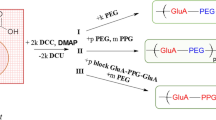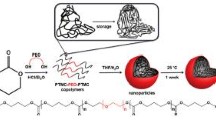Abstract
Pseudolatexes of the biodegradable polyesters poly(D,L-lactide) (PLA) and poly(ε-caprolactone) (PCL) have been developed as potential aqueous coatings for sustained release. Since PLA and PCL are known to hydrolyze, the influence of the surfactant system, temperature, pH, and particle size on the chemical stability of the polymers as aqueous colloidal dispersions was investigated. Pseudolatexes of PLA and PCL formulated with a nonionic surfactant system were the most stable. When these dispersions were stored in unbuffered media for 350 days at 5°C, only small changes in the weight-average molecular weights (M w) of the polymers were observed. At 37°C there was rapid degradation of both polymers in the dispersions. Arrhenius plots for the degradation of PLA and PCL resulted in a linear relationship for PCL. The nonlinear relationship for PLA was attributed to the polymer being in two different physical states within the 5 to 37°C range which was used for the Arrhenius plots. PCL was in the rubbery state at all temperatures studied. Storage of the pseudolatexes in pH 1.65 buffer at 37°C catalyzed the rates of degradation of both PLA and PCL. However, refrigeration of the pseudolatexes stabilized the polymers even at pH 1.65 for up to 4 months. Particle size had an insignificant effect on PLA and PCL stability in pseudolatexes prepared with either a nonionic or an anionic surfactant system.
Similar content being viewed by others
REFERENCES
R. Bodmeier and J. W. McGinity. Solvent selection in the preparation of poly (DL-lactide) microspheres prepared by the solvent evaporation method. Int. J. Pharm. 43:179–186 (1988).
R. K. Chang, J. C. Price, and C. W. Whitworth. Dissolution characteristics of polycaprolactone-polylactide microspheres of chlorpromazine. Drug. Dev. Ind. Pharm. 12(14):2355–2380 (1986).
Y. Cha and C. G. Pitt. A one week subdermal delivery system for L-methadone based on biodegradable microcapsules. J. Control. Release 7:69–78 (1988).
A. K. Banga and Y. W. Chien. Systemic Delivery of therapeutic peptides and proteins. Int. J. Pharm. 48:15–50 (1988).
D. Freifelder, Physical Biochemistry, 2nd ed., W. H. Freeman and Company, New York, 1982.
R. Gurny, N. A. Peppas, D. D. Harrington, and G. S. Banker. Development of biodegradable and injectable latices for controlled release of potent drugs. Drug Dev. Ind. Pharm. 7(1): 1–25 (1981).
K. Makino, M. Arakawa, and T. Kondo. Preparation and in vitro degradation properties of polylactide microcapsules. Chem. Pharm. Bull. 33:1195–1201 (1985).
J. Kopecek and K. Ulbrich. Biodegradation of biomedical polymers. Prog. Polym. Sci. 9:1–58 (1983).
K. Makino, H. Ohshima, and T. Kondo. Mechanism of hydrolytic degradation of poly (L-lactide) microcapsules: Effects of pH, ionic strength and buffer concentration. J. Microencapsul. 3(3):203–212 (1986).
C. G. Pitt and Z. Gu. Modification of the rate of chain cleavage of poly (ε-caprolactone) and related polyesters. J. Control. Release 4:283–292 (1987).
A. Reed and D. Gilding. Biodegradable polymers for use in surgery—poly(glycolic)/poly(lactic) acid homo and copolymers. 2. In vitro degradation. Polymer 22:494–498 (1981).
R. Bodmeier, K. H. Oh, and H. Chen. The effect of the addition of low molecular weight poly (DL-lactide) on drug release from biodegradable poly (DL-lactide) drug delivery systems. Int. J. Pharm. 51:1–8 (1989).
S. L. Ashley. The Preparation and Study of a Drug-Containing Polymeric System Which Displays Enzyme Mediated, Polymeric Degradation, Dissertation, University of Texas at Austin, Austin (1988).
R. K. Kulkarni, E. G. Moore, A. F. Hegyelli, and F. Leonard. J. Biomed. Mater. Res. 5:169–181 (1971).
C. C. Chu. Degradation phenomena of two linear aliphatic polyester fibres used in medicine and surgery. Polymer 26:591–594 (1985).
A. S. Chawla and T. M. S. Chang. In vivo degradation of poly (lactic acid) of different molecular weights. Biomat. Med. Dev. Art. Org. 13:153–162 (1985–1986).
G. E. Zaikov. Quantitative aspects of polymer degradation in the living body. JMS-Rev. Macromol. Chem. Phys. C25(4):551–597 (1985).
Author information
Authors and Affiliations
Rights and permissions
About this article
Cite this article
Coffin, M.D., McGinity, J.W. Biodegradable Pseudolatexes: The Chemical Stability of Poly(D,L-Lactide) and Poly (ε-Caprolactone) Nanoparticles in Aqueous Media. Pharm Res 9, 200–205 (1992). https://doi.org/10.1023/A:1018981222092
Issue Date:
DOI: https://doi.org/10.1023/A:1018981222092




